A bass compressor is a device that makes quiet notes loud and loud notes quiet, thereby equalizing them in amplitude with each other. There are several additional waveforms in addition to these three, although they are not as frequent. It is possible to greatly simplify the extraction of artificial (mediator) flageolets with the help of the best bass compressor.
Here’s a great example when the compressor is rather useful: there’s a need to reduce the difference in volume throughout the entire part of the instrument so that it is always clearly audible against the background of the rest of the instruments. And otherwise, when it’s important not to make an instrument’s level run high (for example, the moment of a loud performance by a lead singer) and not to disguise other elements behind it.
The compressor pedals for bass are indispensable in music industry as the signal quality deteriorates greatly with decreasing amplitude (in digital paths). As a consequence, the sound becomes murky and difficult to perceive. If you record signal on analog equipment, then interfering moments come up (noise in a pause, extraneous signals into microphones, backgrounds, and hissings, etc.). In all these cases, there is a need for automatic control of signal levels, that is, in the use of dynamic signal processing devices (compressors). If you want to choose a good option for yourself, check out the bass compressor pedal reviews and find among surveyed models the one that might satisfy the requirements.
Bass Compressor Reviews
BOSS BC-1X
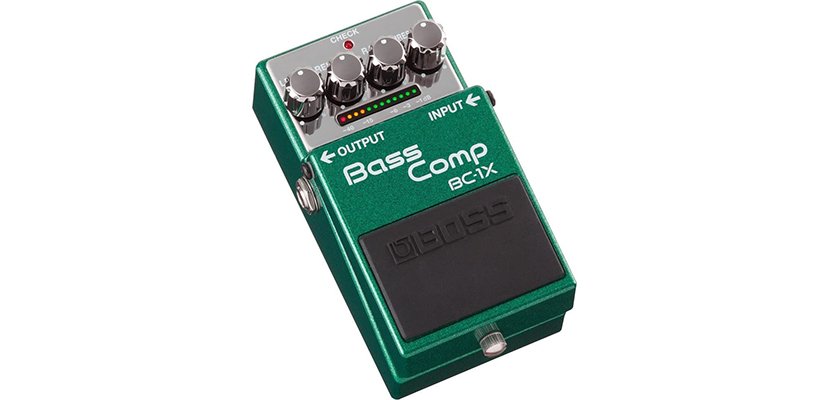
The BOSS BC-1X features a sturdy metal casing that protects the device from dust, damage in the event of a fall, and so on. It is equipped with a well-thought-out circuit that is designed to work freely with a sound signal of different dynamics in any high-altitude registers. Such a peculiarity provides a real-time compression that does not change the timbre of the instrument. It’s able to respond to different dynamics and registers, ensuring that the tone won’t be excessive or dirty (Level, Release, Ratio, and Threshold). This BOSS bass compressor is a sophisticated multiband processor with many specifications – by twisting the knobs, you can adjust several characteristics at the same time. I really like a natural compression that retains the basic bass tone. Every nuance of the sound is stated and processed, even despite aggressive settings.
The 12-segment gain suppression indicators clearly show the amount of compression at any time. The device is powered using a standard 9V battery, and the required current strength is 90mA. This means that the bass compressor pedal will not occupy unnecessary sockets, and the power will not turn off at the most inopportune moment. The BOSS BC-1X is recommended to be used in the chain of effects after the guitar or bass but before all other effect pedals. It is better to locate a distortion pedal into the chain for maximum effect immediately after the specified compressor pedal for bass.
Pros
- A gain indicator provides visual control of compression depth.
- The digital circuitry significantly reduces noise (a flaw inherent in analog compressors).
- The 18V input allows you to connect any bass guitar, providing a clean and powerful sound without any distortion.
Cons
- The power supply has to be purchased separately.
- The ratio knob works with breaks.
Video BOSS BC-1X
Behringer CS400
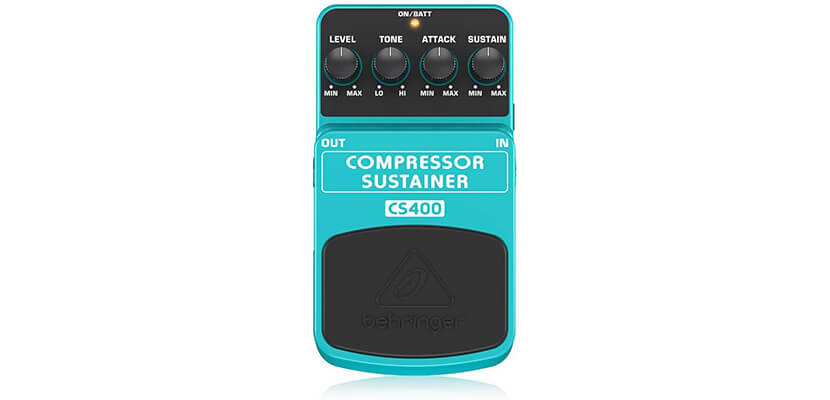
The Behringer CS400 allows getting a smooth, neatly compressed sound, and long sustain. The bass compressor pedal attenuates loud and picks up quiet signals without changing the nature of the timbre. An electronic switch guarantees the silent operation, and an LED indicator provides visual control of the effect and battery status. The device is likely the best bass compressor pedal on the market, however the construction quality is terrible, since the plastic body frame scrapes and is fairly thin.It’s easy to use the Dedicated Level, Tone, Attack, and Sustain controls, which clearly perform their primary tasks. Pay attention that the use of other modulation effect pedals in different places of the pedal chains, paired with the Behringer CS400, sometimes gives a completely unexpected effect, so you can easily experiment and find the sound that meets your requirements. It can easily run on a 9V battery.
Pros
- It suits for both clean guitar and hot rock solo.
- The gadget is simple to use, since the user guide provides all necessary information.
- Despite having a bad assembly quality, the compressor looks modern.
Cons
- When you play quiet notes, the noise becomes noticeable.
- This pedal won’t survive the overzealous foot, so the musician has to be careful with this bass compression pedal.
Video Behringer CS400
Seymour Duncan

The Seymour Duncan studio bass compressor is a soft compression unit that belongs to the studio-grade musical equipment. Its most notable feature is a switcher that controls the frequency band that will be compressed the most. Essential emphasis can be made either on the middle frequencies, or on the low, or the entire range. The Blend knob allows you to add the original signal to the compressed sound, and the Mid/Full/Low positions on the switch give you the opportunity to choose the nature of the sound signal mixing. The Attack controller changes the compressor’s speed in response to the sound’s first pulse (from 8 to 27ms). The tuning position increasing leads to a later reaction, which allows the selected dynamics of sound to affect before compression begins to act. The pedal consumption is 180mA, while it requires a 9-18V DC power supply.
The Volume control gives you the possibility to get soft or extreme increase in sustain for playing different style melodies. When you want to make your sound clear and explicit, you can adjust the Compression knob to the maximum, select an attack to your liking, and then start increasing the Blend value until enough compression in the signal getting. This unit can be probably perceived as the best bass compressor pedal but the bass isn’t really good under gain. It becomes muddy at hard rock and metal levels of distortion.
Pros
- The unit is solid and can cope with heavy load.
- It supports the True Bypass function (switching the input signal directly to the output, bypassing all functional blocks).
Cons
- The unit is rather noisy sometimes.
- It’s easy to lose top end, bottom end, and the whole clarity when using high settings.
Video Seymour Duncan
TC Electronic Spectracomp
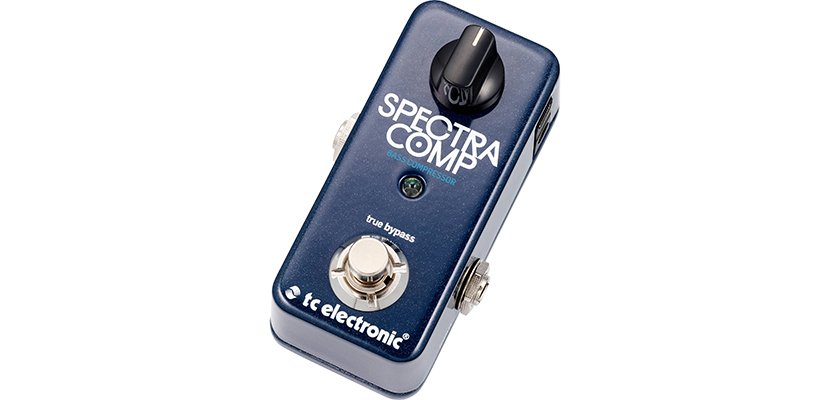
The TC Electronic Spectracomp can be called as one of the best bass compressors as it’s able to set the intensity and other compression parameters for each frequency range separately. Moreover, it effectively tightens low frequencies, carefully preserving the articulation and dynamics of high frequencies. This compressed bass pedal is a multiband gadget with only one knob that controls the signal compression ratio. All you need to do is connect, turn it on, and play. The specified pedal consumption is 100mA while it works with a 9V DC power supply.
It’s really good that the TC Electronic Spectracomp can divide the signal into several parts in the frequency range. Each part is compressed and processed in its own way, which allows, for example, maintaining a rich, uncompressed bottom and a punchy, tight top, and simply pacifying the middle without giving it any attention. The TonePrint Editor software is an essential part of the device. You may fine-tune anything with this software or use presets from world-famous bass players. It is enough to take a preset and load it onto the pedal.
Pros
- Its body frame is made of metal.
- It is complemented with a True Bypass and a USB connector that works seamlessly.
- The pedal may be disassembled if required by unscrewing just one screw in the center.
Cons
- The device isn’t battery-powered, which may be uncomfortable for some users.
- Sometimes the connection to the phone application can be lost.
Video TC Electronic Spectracomp
Mimidi Super Mini
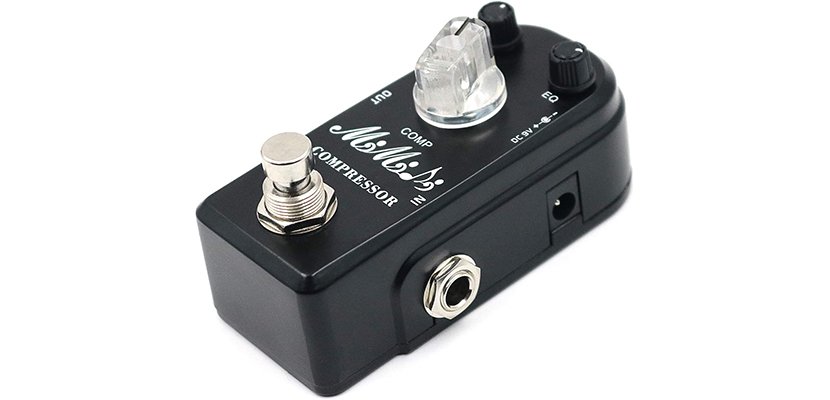
The Mimidi Super Mini has a metal shell that is able to cope with a heavy load. This gadget can only be powered by a 9V DC AC adaptor. I was surprised to hear some echo during the test. The sound wasn’t spoiled despite this particularity. The low noise level is an indicator of quality. Pay attention that you might need nearly 20 minutes to puzzle out in settings and pick up the signal strength into the amp. I especially like rich analog tremolo sounds that fit classic bass tracks playing. Its small footprint is rather comfortable to use. Some guitar players may perceive it as the best compressor for bass as the device has only 3 function knobs (LEVEL, EQ, and COMP), which make it easier to control the compression process. Its current draw is 30mA that is a good indicator.
Pros
- The unit is amended by the True Bypass that helps get a zero tone coloration.
- Its circuits are fully adapted to the electric bass guitar peculiarities.
- This delay pedal’s maximum duration is 600ms.
Cons
- The speed knob taper is too sensitive that even small touching leads to serious changes.
- There are some scratches on the body frame, despite being made of metal.
MXR M87

The MXR bass compressor has a complete set of controls specific to studio compressors: Attack, Release, Ratio, Input, and Output, which makes it possible to accurately tune the sound. The Attack potentiometer adjusts the response time of the compressor to the actual attack. A feature like this enables you to compress the signal immediately from the time it hits the strings or to postpone the attack. Release controls the rate at which the signal returns to its original level (when the extracted note is silent). As a result, you may alter sustain after the following phrase by utilizing this bass compression pedal. Talking about the Ratio, the natural sound admirers will appreciate the 4:1 setting, which will allow you to preserve the features of sound production and only slightly align the dynamics of the play. Thrill-seekers will like the limiter mode at positions 12:1 and 20:1, in which there is a strong equalization of dynamics. The Input sets the signal threshold above which compressor operation begins. Specified Output is an output level control that has to be twisted if you use strong compression.
You have access to all the bass compression options: from light peak limitation to a hard-over-compressed effect. The Constant Headroom Technology provides extended dynamic range and accurate compressor operation. The MXR M87 ensures that the full dynamic range is maintained until the signal reaches the threshold, which can be seen on the LED display. The device’s attack time can reach 800ms.
Pros
- The pedal is housed in a sturdy and lightweight aluminum body frame.
- Power can be supplied via a 9V battery or AC adapter.
Cons
- The LED has a tendency not to work from time to time.
- All the scratches are greatly visible on the white body frame.
Video MXR M87
Sonicake BOOM

The Sonicake BOOM has 4 modules for bass playing (Boost/Comp, Fuzz, Preamp, and Octave). The Boost brings warm compression, while the Fuzz influences the aggressive sound. The preamp is a standard one (with 3-band EQ) and the Octave is dual sub-octave. Furthermore, the ratio between the original dry signal and the octaves may be mixed. Its current consumption is 60mA. Perhaps, this unit isn’t the best bass compression pedal due to some noise, but the Sonicake BOOM pedal is made in a compact black metal housing and has a clear marking of all connectors and controls. It’s recommended to use only stabilized power supplies. This pedal is not designed to operate on batteries for environmental reasons. You may use the manual to specify the locations of all controls in order to get the most dramatic effects. However, self-tuning the nature of the sound of the guitar will bring many interesting options.
Pros
- The XLR output makes it easy to hook up the audio mixer.
- FX Loop is a good choice for connecting other effects.
- You may connect the DC 9V power adaptor.
Cons
- Octave and sub-octave sometimes bring some muddy sound.
- Some distortions appear at a high signal level.
Video Sonicake BOOM
Darkglass Hyper Luminal
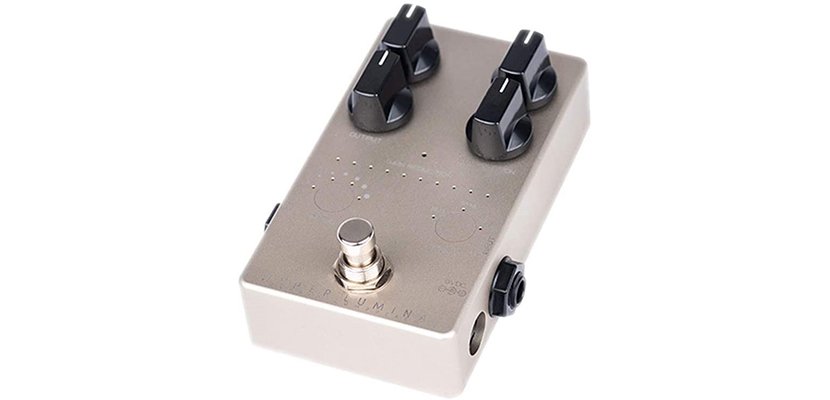
The Darkglass Hyper Luminal is based on an analog VCA compressor stage controlled by a digital side-chain with unique algorithms. Such a peculiarity makes it possible to get this studio instrument in a compact pedal format, as well as create your own original compressor sound. Pay attention that the entire signal path remains purely analog, while digital circuits perform only a control function. The pedal panel of this, perhaps the best compressor for bass guitar, seems easy and familiar to any musician. In addition to it, there are 4 traditional knobs of regulators on the front side of the unit.
The Blend allows you to mix the original signal with a compressed one. This is a good option for a high sound density without squashing the dynamics achieving. The Output sets the overall output level of the effect. The Time regulates the ratio of Attack and Release. When talking about the Compression, it is responsible for the compression level. Meanwhile, it regulates the compensatory gain level so that the volume stays constant at whatever compression level. This potentially the best bass compressor also has a regulator that sets the compression ratio and can significantly change the sound. It is powered by a standard 9V DC power supply and its current consumption is 250mA.
Pros
- You can rebuild all the parameters in the Darkglass Suite software by connecting the pedal to the computer via the USB port.
- The LED indicator of the signal compression level helps tune the device and monitor its operation.
Cons
- This pedal is very sensible.
- The croaking sound is heard within the gadget; it seems that certain components are not securely connected.
Video Darkglass Hyper Luminal
Buyer’s Guide
Reasons to Buy the Bass Compressor
Bass is the basis of the whole mix, without which the song loses energy. It is the bass that gives the track character and dynamics, makes the song dray and swaying. The bass notes fade out too quickly without a compressor; the bottom of the mix becomes weak and flabby so the track loses its fullness. The bass compressor eliminates this problem and simplifies balancing the volume – bass sounds are at the same level, they do not go forward but also do not hide in the mix.
Pay attention that when you are playing, the dynamics are everywhere. The bass compression settings allow taking the peaks and squashing them down. It is difficult, if not impossible, to manage the volume knob manually all of the time, so the specified unit comes to the hand and reduces the level when it becomes too loud and obnoxious. A trill, tapping, and legato can be performed much easier with the guitar compressor turned on. The sound becomes more even, the notes do not fail. You can add “anger” to the distortion effect without twisting the Output Gain knob all the way. This works well with heavy rhythm guitars.
Things You Need to Consider Buying the Bass Compressor
Bass Compressor Controls
The compressor seems to be a complex and incomprehensible tool for beginners. The device itself has several basic controls:
- Threshold (determines the moment the bass guitar compressor is turned on. The value of this parameter indicates after which mark the signal will undergo compression).
- Knee (determines how abruptly the signal transits from uncompressed to compressed state).
- Attack (it specifies the time taken by the compressor to process signals that have crossed the threshold).
- Release (it’s a parameter opposite to the attack, which determines the time taken by the compressor to restore the signal to its original unprocessed state).
- Ratio (determines the signal attenuation strength and signal changes in comparison with the original value. For example, a value of 5:1 means that when the input signal changes to 5dB, we get a 1dB difference at the output).
- Output Gain (due to the fact that compression changes the signal level, this regulator helps restore gain).
If you are working with the bass compressor for the first time, it’s recommended that you start with the basic compression settings: ratios in the region of 3:1-4:1, slow attack (100ms), and fast release (25ms). The response threshold has to be set about 5-10dB. Lower the attack until the bass loses aggression and its sound becomes dull. Return the attack control a few milliseconds back to restore the cut off transients (the attack peaks of the sound signal). Your task is to ensure that the attack is at a level close to the loss of transients, otherwise, the sound will lose all power.
Main Bass Compressor Types
It’s possible to distinguish the following compressor types:
Optical
In the control circuit of the optical compressor, there is a unique optical-electric element. This element consists of either a luminescent panel or a light-emitting diode that irradiates a photosensitive resistor. Put simply, the higher the signal level, the more light the diode emits to the resistor, which, in turn, affects the amplification of signal compression. Since the photosensitive resistor has inertia, it reacts rather slowly to changes in light intensity. Compressors have natural-sounding attack and recovery. A drawback of optical compressors is slowness as they are not “agile” enough to catch transient peak values.
VCA
Compressors based on VCA are much faster than optical ones, and due to this, they cope much better with attenuation of peak values. In addition, they have an incredibly high level of attenuation, which is useful when you really need to “crush” the signal. The VCA compressors have a fairly wide range of quality as there are no modulation artifacts (with rational settings).
FET
More recently, field-controlled compressors have appeared on the market. They use a field transistor as a control element, which has its pros and cons. On the one hand, the attack on it is much faster than on optical compressors, and even faster than many VCA devices. On the other hand, the field-effect transistor has a rather limited dynamic range, so at high signal levels, field-effect transistor compressors may distort the sound.
Tube
Such compressors are expensive and hard to maintain, as they are complemented with vacuum tubes in the signal path. They are rather rare, but units are able to provide the music with unique vintage and warm tones.
True Bypass or Buffered Output
A True Bypass bass compression pedal won’t have any effects on the sound while being turned off. It keeps the sound clean and 100% realistic. A Buffered Output compressor pedal boosts the signal at any state (whether it’s turned on or off). The last one is useful when you use pedals and long cables. You should know that while the signal runs through the cable, it loses some high frequencies. The Buffered Output reduces that loss via boosting the signal before it hits the amp. It’s important to sort out priorities and choose True Bypass or Buffered Output for various sound goals getting.
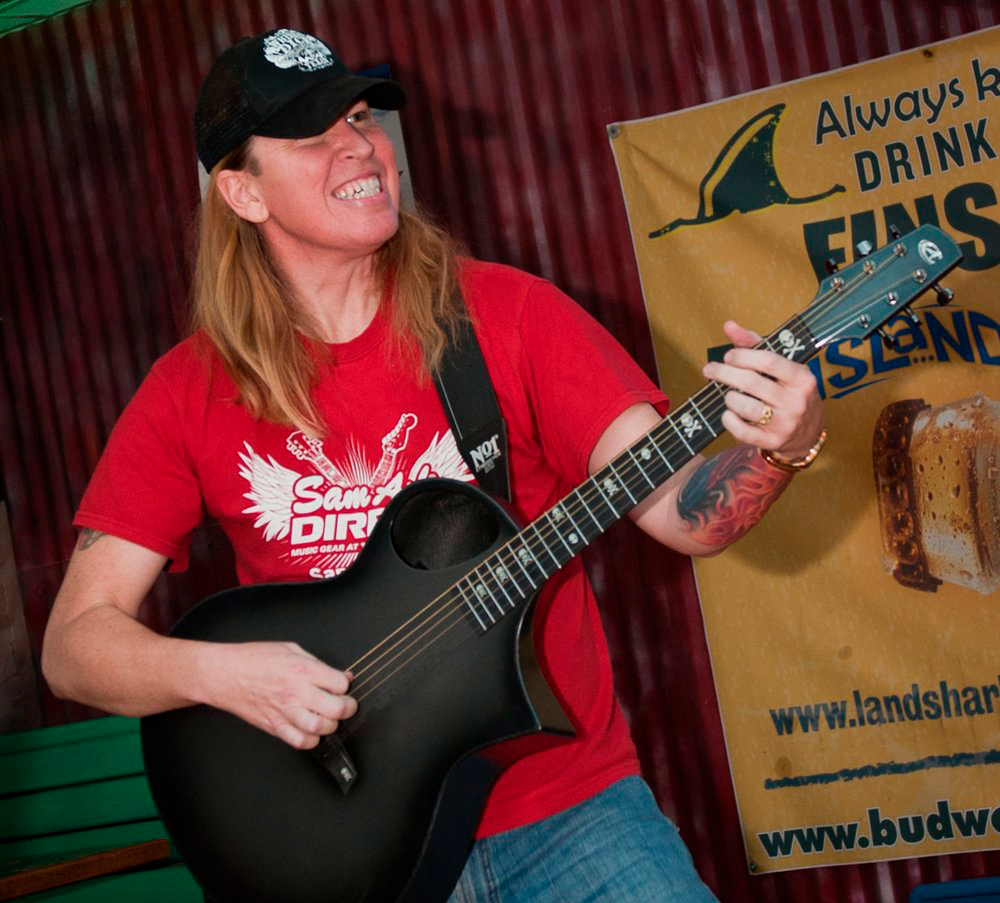
Hi everyone! I’m Thomas Moody, also known as Guitarzan.
